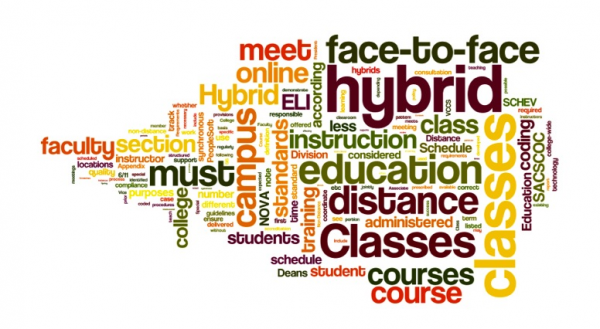Hybrid courses, often known as blended courses, are college-level academic classes that combine classroom requirements with online instruction.
They are called hybrid courses because they can’t be categorized solely as typical face-to-face classroom courses or online courses. They are a combination of both. Depending on the teacher’s goals and instruction methods, a larger or smaller percentage of the course requirements might require in-class time. Online portions of the class are designed to complement classroom lectures, activities and discussions without repeating the identical content.
Best of Both Worlds
Hybrid courses are beneficial for teachers and students because they incorporate web technology into the learning environment to support classroom concepts without eliminating face-to-face classroom interactions. Students and teachers spend less time, and less money for commuters, traveling to and from classrooms for study sessions, recitations, special projects and tutoring because much of that occurs online. Courses in which more than 80 percent of the learning activities take place in the classroom are often labeled hybrid courses, rather than Web-enhanced classes, according to the University of Wisconsin Milwaukee.
Happy-Go-Lucky Options
Many hybrid courses are advantageous because they offer more flexibility than regular classroom-only courses. Students must budget their time to accommodate face-to-face classroom requirements but can work on web-enhanced assignments on their own time. Online course supplements can be accessed from almost any computer, so they offer convenience for students who might have jobs, additional academic courses or personal responsibilities. Classroom meetings which are lessened also free up academic schedules to suit meal times, social functions, sleeping, homework and team-centered assignments.
Techno Troubles
For students who don’t have the online technical skills, blended courses are not advantageous to them. They will have the struggle to navigate web pages or online blackboards or have difficulty creating, organizing, naming, attaching and sending electronic files. Students must also participate in online discussion boards and send email messages to classmates and teachers on a regular basis. Younger generations have grown up with computer technology at their fingertips, but non-traditional students and those re-enrolling in academic programs after years in the workforce might find the technological requirements of hybrid courses to be frustrating and time-consuming.
Mind Over Matter
Nearly all college courses require dedication and commitment, but hybrid classes require even more self-discipline and self-motivation. Procrastination can make hybrid classes even more challenging. Students must learn to check their email accounts frequently and respond to incoming messages, follow up on electronic blackboard assignments and interface with teachers and classmates outside of typical classroom settings. It takes self-discipline to work on web-enhanced assignments when teachers aren’t taking roll or physically monitoring student participation.

